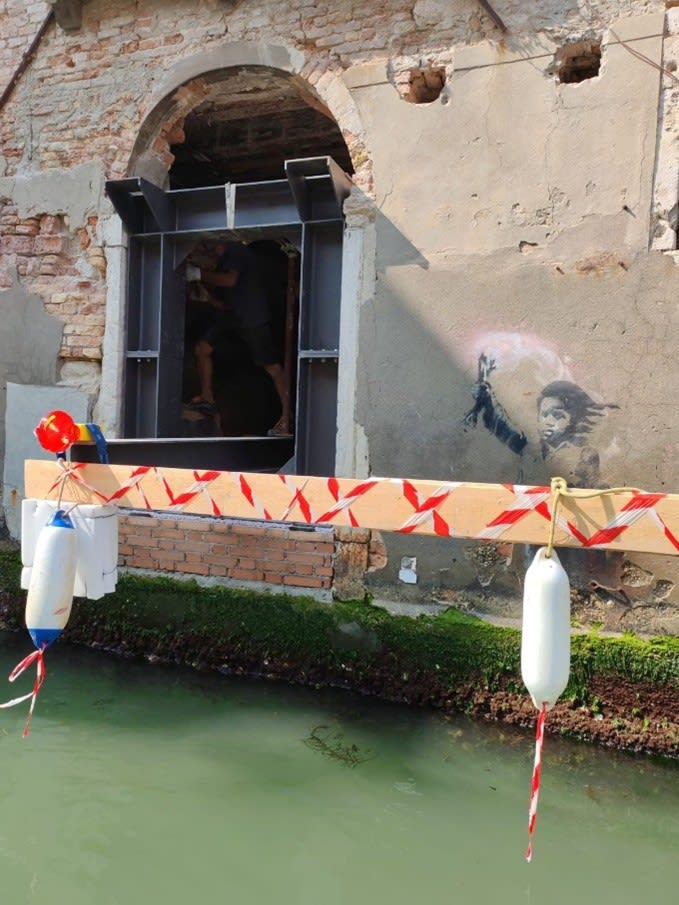
On 24 July 2025, Venetian authorities and art conservation teams undertook a delicate intervention to rescue one of Banksy’s most iconic public works in Italy, The Migrant Child, by removing it from the once-derelict façade of Palazzo San Pantalon in Venice. First painted in early May 2019 during the Venice Biennale, the mural quickly garnered international attention after Banksy himself acknowledged it. The image, a small child in a life jacket clutching a pink smoke flare, feet submerged in Venice’s lagoon waters, has long been read as a poignant symbol of sea‑borne migration and humanitarian crisis. However, over six years of relentless exposure to humidity, high tides and salt spray had taken their toll: an estimated thirty percent of the mural had deteriorated beyond recognition. Located within a few metres of canal water, its lower portion suffered especially from erosion and structural instability. In June 2025, scaffolding went up around the palazzo- not merely to restore the building, but explicitly to begin the conservation process for the fragile artwork.
The building, famously long-uninhabited, was acquired in 2024 by Italian banking group Banca Ifis, which funds art and cultural projects through its Ifis Art initiative. The bank commissioned Zaha Hadid Architects, alongside local firm Th&Ma Architettura, to lead a broader redevelopment of Palazzo San Pantalon into a publicly accessible exhibition space tied to the Venice Biennale. Restoration expert Federico Borgogni, known for prior treatment of Banksy murals, led the conservation effort. Initial stages included surface cleaning, dust removal, consolidation of existing plaster, and preparation for detachment. Over the night of 23–24 July 2025, technicians undertook the innovative step of cutting a section of the original wall substrate containing the image, lifting that panel onto a barge and transferring it to a laboratory. According to Banca Ifis, the lower portion of the artwork was so irreparably degraded that restoration would not reconstruct it, but rather stabilise what remained, maintaining the integrity and material authenticity of the piece. The conserved fragment will be mounted on a honeycomb backing tray, then undergo selective infilling of losses in plaster and tone-matched inpainting. The aim is subtle visual cohesion without fabrication of missing sections. The restoration approach is noteworthy for its technical innovation. Detaching a painted mural embedded in historic brickwork is rare in Italy. The process pioneered here, cutting and relocating a wall fragment, opens a potential roadmap for preserving other time-sensitive street art in climate-exposed urban sites.
Once restoration is complete, Banca Ifis intends to re‑exhibit Banksy’s Migrant Child publicly, free of charge, as part of its cultural programming. Whether the work returns to its original canal‑side location, or is shown within the restored palazzo or elsewhere in Venice, is still under evaluation. The decision to remove and conserve the mural has elicited both praise and critique. Supporters cite the public responsibility to preserve a socially powerful work that is rapidly fading. Critics, ranging from artists to heritage professionals, argue that the mural’s impermanence was intrinsic to its meaning. As street artist Evyrein told Euronews in 2023: “Banksy was no fool; he was fully aware that his waterside creation wasn't meant to endure. Restoring it goes against the grain.” In Italy, only artworks older than 70 years qualify for state conservation mandates. The fact that authorities and Banca Ifis nonetheless pressed forward underscored their view of the mural as urgently endangered public cultural heritage. Venice’s mayor Luigi Brugnaro and the Veneto region governor Luca Zaia enlisted Vittorio Sgarbi, former undersecretary for culture, to advocate for the intervention, underscoring its political as well as artistic dimensions.
This project offers more than a conservation milestone; it is a moment to reflect on the intersections of street art, architecture, public discourse and cultural memory. Banksy’s Migrant Child began as a socially engaged commentary chronicled in Venice’s street art mythos; now its rescue speaks to broader themes of climate risk, urban ephemera and artistic agency. The decisions taken, whether to remove or let decay proceed, pose fundamental questions about authenticity, transience and who gets to save public art. As the city of Venice, the art world, and cultural institutions grapple with rising water and overtourism, the fate of The Migrant Child underscores an urgent tension: should art that emerges from marginality and impermanence be preserved at all costs, or should its natural lifecycle be seen as part of its meaning? For now, Banca Ifis and their partners have chosen preservation: removing a fragment of a building to prolong the voice of a child painted in pink smoke.
